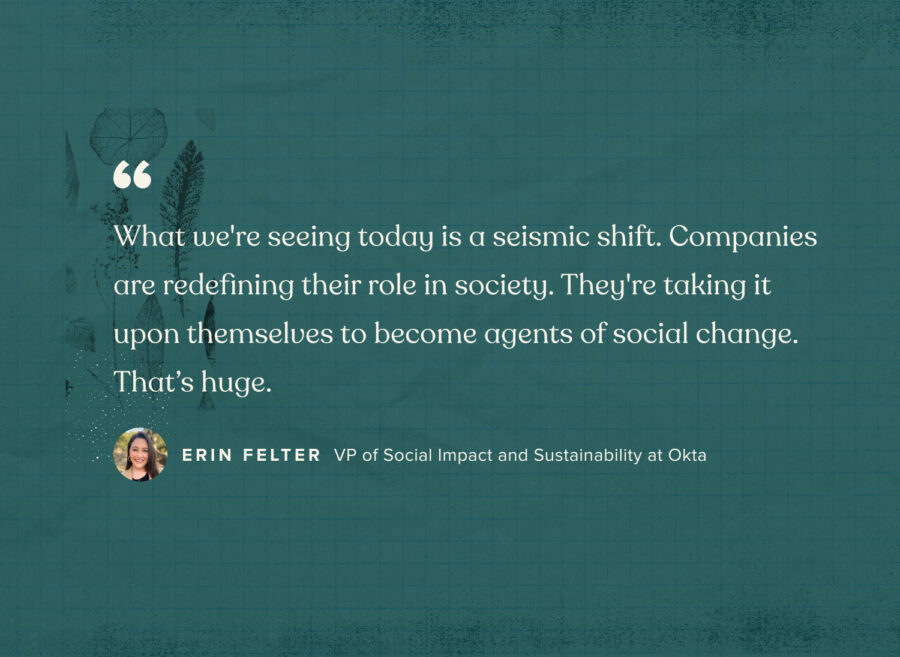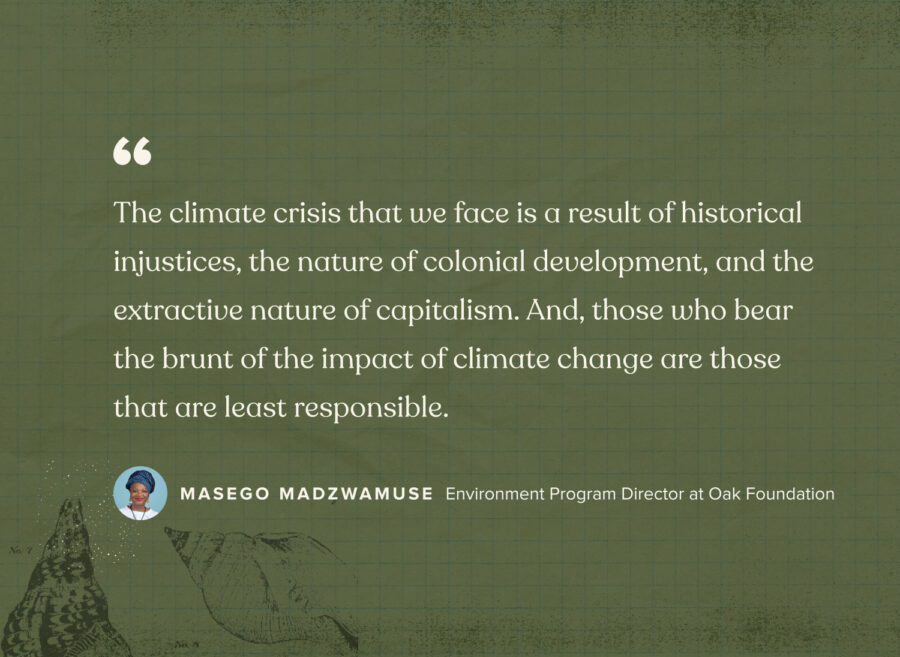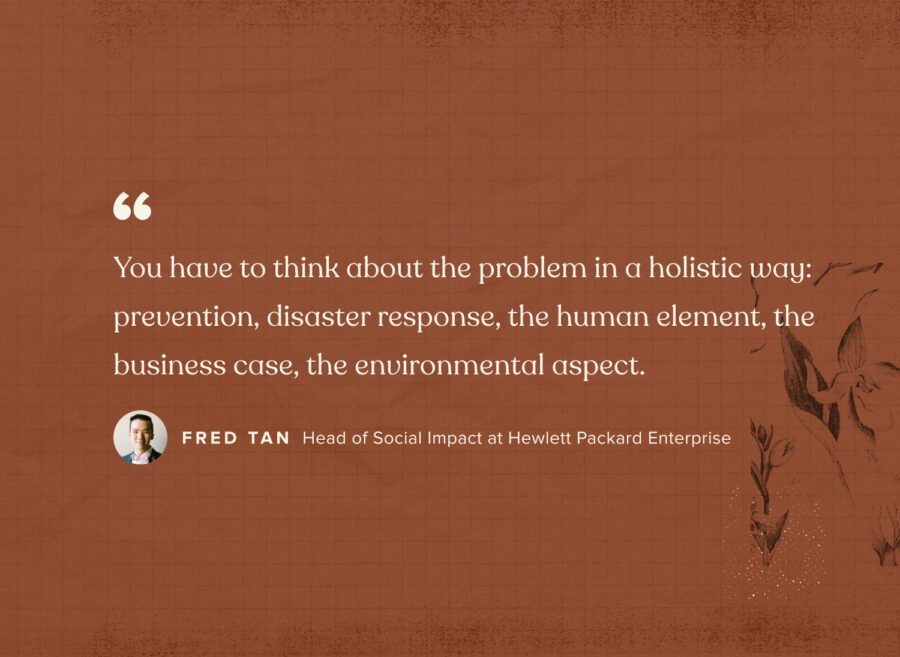According to a recent report, only 2% of philanthropic dollars go toward addressing climate change. Compare that to the colossal, far-reaching impacts of climate change and something doesn’t add up.
Philanthropic funders do understand the urgency of climate change. In fact, nearly all foundation leaders (97%) and nonprofit leaders (94%) agree that climate change is an urgent issue.
The fact that, despite this awareness, climate mitigation still represents such a small percentage of overall philanthropic giving speaks volumes: Funders know climate change should be part of their work, but aren’t sure exactly how to incorporate it.
CSR professionals are in a unique position to help close this gap, standing at the crossroads of corporate influence and global environmental stewardship. You may feel like David facing Goliath—the scale of the problem is immense, and the solutions complex. But therein lies an uncharted opportunity.
While philanthropy is currently the main player in funding climate solutions, this moment is a call to action for the corporate sector. Climate change shouldn’t be a nice-to-have, but rather an imperative for all CSR programs. CSR strategy can lead the way: not just to fill the funding gap, but to make sustainability a central pillar of CSR.

The dual opportunity of CSR and climate change
In reality, the intersection of CSR and climate change is not just an area of responsibility—it’s ripe with opportunity. Through CSR, companies can use their resources and influence to move the needle on climate change, both inside and outside the organization.
Externally, companies have the power to propel the climate action movement forward through targeted grants and funding. By supporting nonprofits and community organizations dedicated to fighting climate change, businesses can amplify efforts that are already making an impact. It’s about strategically channeling corporate funds to where they can make the most difference in the environmental sphere.
Internally, there’s a vast landscape of opportunities for companies to revamp their own operations to be more sustainable. Think about it as aligning your company’s everyday practices with the broader goal of reducing environmental impact.
Fred Tan is the head of social impact at Hewlett Packard Enterprise. He points out that business decisions like expansion should factor sustainability as a core part of the equation.
“I talk with our global workplace teams when we look at purchasing new real estate. When we look at where to expand our footprint, we look at the environmental and the social aspects,” Tan says.
There’s an added benefit here of meeting ESG goals by integrating sustainability into overall business operations. The company does its part for the environment, while also demonstrating its commitment to investors and consumers, who are increasingly more conscious of a company’s environmental and social footprint.
As a CSR professional, you have the unique ability to orchestrate these internal and external efforts, ensuring that they’re not just parallel tracks, but deeply interconnected. Make sustainability a foundational element of your company’s identity. By aligning what you do inside your company with how you invest in the external world, you create a powerful, cohesive approach to tackling climate change.
How to choose the right climate strategy
When it comes to tackling climate change through environmental CSR, your approach should be guided by a clear understanding of how your company’s resources and expertise can make the biggest impact.
Here’s a breakdown of different strategies and examples to help you determine the best climate strategy for your organization.
Mitigation
Mitigation efforts focus on actively fighting to halt or reverse the effects of climate change. This strategy is about getting to the root of the problem—reducing greenhouse gas emissions, enhancing carbon sinks, and promoting sustainable practices.
In the context of CSR, this can include initiatives aimed at cutting emissions, investing in renewable energy, or supporting reforestation projects. It’s all about proactively doing what you can to fight climate change from happening.
Example: The Honnold Foundation supports nonprofits that advance renewable energy and solar energy, especially in marginalized communities—directly contributing to the reduction of reliance on fossil fuels. Their efforts demonstrate how targeted investments in renewable energy can make a tangible difference in mitigating climate change. Learn more about their impactful work here.
Adaptation
Adaptation strategies are about helping communities prepare for and adjust to the changing climate. This could involve investing in infrastructure to withstand extreme weather, supporting agricultural practices suited to altered climate conditions, or developing climate-adaptive technologies.
Adaptation strategies in CSR recognize that climate change is not just a future threat, but a current reality for many. By focusing on adaptation, companies can demonstrate their commitment to sustainability and their readiness to respond to the evolving needs of the planet and its inhabitants.
Example: Desolenator aims to waterproof communities, providing them with access to clean water using solar energy, driving net-zero desalination at scale. Companies could use net-zero water from Desolenator for their operations instead of water that comes with climate change implications.
Advocacy
Advocacy involves working across public and private sectors to shape policies that prioritize climate concerns. This approach involves using a company’s influence and resources to drive policy changes, raise awareness, and create a broader impact beyond direct operational changes.
CSR advocacy initiatives could include financial backing for nonprofits and political action groups at the forefront of climate action, creating public awareness campaigns, and actively reporting on climate change social impact results for greater visibility into climate change as a prevalent issue.
Example: Evergreen Action focuses on advocating for comprehensive climate policies that aim to tackle the climate crisis head-on. Their mission revolves around pushing for bold policy changes at both the state and federal levels, including promoting clean energy, reducing carbon emissions, and ensuring environmental justice. Companies could partner with nonprofits like Evergreen Action to advocate for policy change or increase awareness around climate issues.

Build climate programs around your social impact
Fighting climate change doesn’t mean abandoning your other values that drive social impact. In fact, integrating these values into your climate strategy can make it that much more effective. For instance, if supporting innovation is a core CSR value, funding cutting-edge solutions to environmental problems ties your climate strategy back to that focus.
As Erin Felter, VP of Social Impact and Sustainability at Okta notes, integrated CSR—weaving social impact into your business mission—leads to more long-term, transformative change.
“What we’re seeing today is a seismic shift. Companies are redefining their role in society. They’re taking it upon themselves to become agents of social change,” says Felter. “That’s huge.”

When your approach to environmental challenges aligns with the principles and mission that define your CSR strategy, it keeps your messaging consistent with your actions, and resonates more deeply with your stakeholders. It shows that your commitment to sustainability is not just a response to external pressures, but a reflection of what your company genuinely believes in.
And as millennials and Gen Z comprise more of your workforce and consumer base, it’s increasingly important for businesses to align with what they care about, which includes ethics, sustainability, and social change.
Add a justice lens
Addressing climate change requires a critical approach to understanding and addressing the complexities of the issue. It all starts with recognizing the root causes of climate change and the fact that climate change is not just an environmental issue, but one of social and economic inequity.
Climate change is a global issue that affects us all, but not all of us are affected equally. As Masego Madzwamuse from the Oak Foundation points out, “The climate crisis that we face is a result of historical injustices, the nature of colonial development, and the extractive nature of capitalism. And, those who bear the brunt of the impact of climate change are those that are least responsible.”

Climate-focused CSR initiatives must therefore adopt an equity lens that recognizes how climate change disproportionately affects marginalized communities. These communities often face the greatest risks from environmental degradation, yet have the least resources to adapt or respond. Integrating this understanding into CSR strategies ensures that efforts are targeted where they are most needed and can have the greatest impact.
Looking through a justice lens also means strategically choosing who to support in the fight against climate change. As Fred Tan highlights, “Only two percent of global venture capital goes to women founders. That means that women founders who are developing some of the most cutting-edge and innovative solutions—their products, their services—don’t really even get a chance to succeed.”
By directing resources and support towards underrepresented innovators, including women and minority-led climate action initiatives, companies can uplift a more diverse and inclusive range of sustainable solutions. In this way, your CSR programs can contribute to initiatives that are environmentally responsible and socially equitable, acknowledging the nuanced context of the climate crisis and its disproportionate impact on various communities.
Support community-led solutions
When it comes to addressing the colossal challenge of climate change, your own local community is often the best place to start. Community-led solutions are crucial in the fight against climate change, as local communities often have the deepest understanding of what will work best for their specific circumstances.
For CSR initiatives to be genuinely effective, they must be “community-led” both in name and in practice. Research suggests that when climate change initiatives ask what a community needs but don’t give the community any ownership or agency in the project, the projects don’t perform as well as expected. Instead, involve communities from start to finish, from identifying needs to implementing solutions and distributing aid.
Practice trust-based philanthropy by building relationships based on mutual respect and shared goals. Give communities the trust and resources they need to lead the way in developing and executing climate solutions.
According to Shaady Salehi, director of the Trust-Based Philanthropy Project, the key is self-reflection and eagerness to learn, approaching communities as not just beneficiaries, but valuable partners.
“Funders that can do the work humbly and with a willingness to self-reflect and learn and shift and make course changes and take the lead of nonprofits in informing those course changes — those, to me, are the qualities that make a great trust-based funder,” says Salehi.
The Global Greengrants Fund is an example of uplifting local communities by supporting grassroots-led efforts to address local environmental issues. As their website says, “We let local people take the lead. Global Greengrants Fund is different from other international organizations in that we don’t try to dictate an agenda from afar. Instead, we trust local people to advance solutions and strategies that will best fit their needs, providing them the resources to make their ideas a reality.”
This is an approach that CSR professionals can adopt as well, trusting local grassroots operations to do the work that’s needed most, and enabling local communities to take charge of how to best protect their environment.
Embrace true innovation
Climate change requires real innovation—not just in technological advancements, but also in our approach to crafting solutions. True innovation in the context of CSR means thinking outside the conventional box in terms of funding and what your support should look like.
Choosing to fund innovation, you have to surrender complete control over the result. As Fred Tan notes, “If you’re 100 percent sure of what you’re going to get because of what you put in, then that’s probably not incredibly innovative.”
Tan recalled a story about Puerto Rico, a major manufacturing base for HPE that had been hit by 13 hurricanes over the years. When thinking about how to provide aid to the community, HPE considered traditional forms of disaster relief, but then decided on a more dynamic solution: Building an on-site cogeneration plant powered by 100% renewable natural gas. This facility not only kept operations running during extreme weather conditions, but also served as an independent energy source and shelter for the community.

“You have to think about the problem in a holistic way: prevention, disaster response, the human element, the business case, the environmental aspect,” says Tan.
By thinking about CSR without limitations, you can address community needs more effectively and sustainably.
The time is now to take climate action
Integrating climate change into your CSR program is no longer optional—it’s non-negotiable. The urgency of the issue—combined with the growing focus and attention from consumers, employees, and the broader public—makes now the critical moment to weave sustainability into the very fabric of your business mission and CSR initiatives.
The journey towards a sustainable future is a collective effort, and your company has a pivotal role to play. By integrating climate action into your CSR strategy, you not only contribute to a more sustainable world, but also position your business as a forward-thinking and responsible leader.
Adopt CSR software today to streamline and amplify your climate action efforts. And for ongoing insights and inspiration on sustainability and the future of CSR, make sure to tune into the Impact Audio podcast.